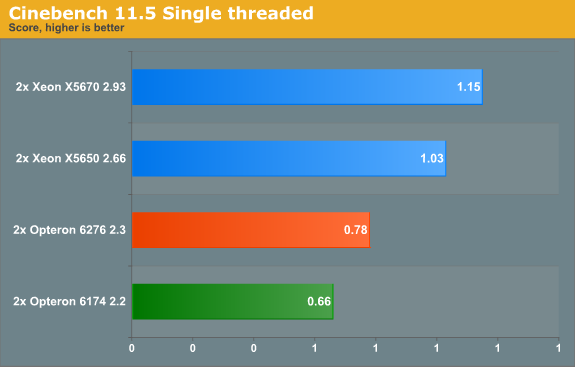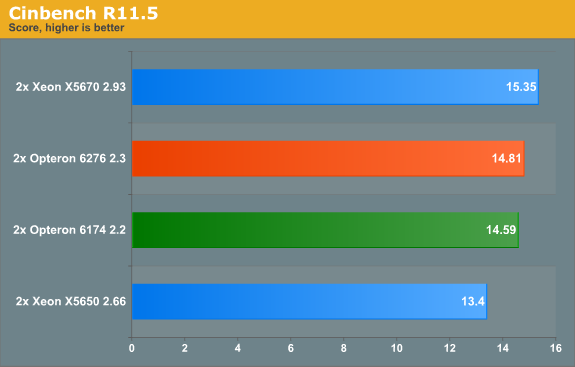Bulldozer for Servers: Testing AMD's "Interlagos" Opteron 6200 Series
by Johan De Gelas on November 15, 2011 5:09 PM ESTRendering Performance: Cinebench
Cinebench, based on MAXON's software CINEMA 4D, is probably one of the most popular benchmarks around, and it is pretty easy to perform this benchmark on your own home machine. The benchmark supports 64 threads, more than enough for our 24- and 32-thread test servers. First we tested single-threaded performance, to evaluate the performance of each core.

Single-threaded performance is relatively poor when you do not enable Turbo Core: with that setting the Opteron 6276 scores only 0.57. So the single-threaded FP performance is about 10% lower, probably a result of the higher FP/SSE latencies of the Interlagos FPU. However, the 6276 Opteron can boost the clock speed to 3.2GHz. This 39% clock speed boost leads to a 37% (!) performance boost. The difference with the older "Istanbul" based Opteron "Magny-cours" 61xx can only get larger once software with support for the powerful FMAC and AVX capable units is available. Also newer compilers will take the longer FP latencies into account and will probably boost performance by a few percent even without using FMAC or AVX.
Before we look at the Multi-threaded benchmark, Andreas Stiller, the legendary German C't Journalist ("Processor Whispers") sent me this comment:
"You should be aware that Cinebench 11.5 is using Intel openMP (libguide40.dll), which does not support AMD-NUMA"
So while Cinebench is a valid bench as quite a few people use the Intel OpenMP libraries, it is not representative of all render engines. In fact, Cinebench probably only represent the smaller part of the market that uses the Intel OpenMP API. On dual CPU systems, the Opteron machines run a bit slower than they should; on quad CPU systems, this lack of "AMD NUMA" awareness will have a larger impact.

We did not expect that the latest Opteron would outperform the previous one by a large margin. Cinebench is limited by SSE processing power. The ICC 11.0 compiler was the fastest compiler of its time for SSE/FP intensive software, even for the Opterons (up to 24% faster than the competing compilers), but it has no knowledge of newer architectures. And of course, the intel compiler does favor the Xeons.
The Opteron 6200 has a total of eight dual issue (if you count only those pipes that do calculations) FPUs, while the Opteron 6100 has a total of 12 dual issue FPUs. The only advantage that the 6200 has (if you do not use the FMAC or AVX capabilities) is that it can interleave two FP threads on one module. So you get 16 FP threads that can dispatch one FP per clock versus 12 FP threads that can dispatch two FP per clock. That capability is especially handy when your threads are blocked by memory accesses. This is hardly the case in Cinebench (but it is probably the reason why Interlagos does so well in some HPC tests) and as a result, the Opteron 6276 cannot pull away from the Opteron 6174.
Anand reported that the best Core i7 (2600K, 4 cores/8 threads, 3.4GHz) achieves 6.86. So considering that a dual Opteron 6200 is cheaper than the dual Xeon, and more manageable than two workstations, such a renderfarm may make some sense.










106 Comments
View All Comments
geoxx - Friday, December 9, 2011 - link
Sorry but neotiger is totally right, choice of benchmark sucks. We are not helped *at all* by your review.What company 32-core server is being used for 3D rendering, cinebench, file compression, truecrypt encryption??
You benchmarked it like it was a CPU of the nineties for a home enthusiast.
You are probably right pointing us to http://www.anandtech.com/show/2694 but your benchmarks don't reflect that AT ALL. Where are file compression, encryption, 3D rendering and cinebench in that chart?
Even performances per watt is not very meaningful because when one purchases a 2-socket or 4-socket server, electricity cost is not an issue. Companies want to simplify deployment with such a system, they want this computer to run as fast as a cluster, in order not to be bound to cluster databases which are a PAIN. So people want to see scalability of applications to full core count on this kind of system, not so much performances per watt.
Virtualization is the ONLY senseful benchmark you included.
TPC as suggested is a totally right benchmark, that's the backend and bottleneck for most of the things you see in your charts at http://www.anandtech.com/show/2694 , and objection on storage is nonsense, just fit a database in ramdisk (don't tell me you need a database larger than 64GB for a benchmark), export as block device, then run the test. And/or use one PCI-e based SSD which you certainly have.
http://www.anandtech.com/show/2694 mentions software development: how much effort does it require to set up a linux kernel compile benchmark?
http://www.anandtech.com/show/2694 mentions HPC: can you set up a couple of bioinformatics benchmarks such as BLAST (integer computation, memory compare), GROMACS (matrix FPU computations) and Fluent? Please note that none of your tests includes memory compares and FPU which are VERY IMPORTANT in HPC. Gromacs and fluent would cover the hole. Bioinformatics is THE hpc of nowdays and there are very few websites, if any, which help with the choice of CPUs for HPC computing.
For email servers (37%!) and web servers (14%) also I am sure you can find some benchmarks.
Iketh - Tuesday, November 15, 2011 - link
I'm not sure how the discovery of cores running in their power-saving state for far too long is anything new. My 2600k refuses to ramp up clocks while previewing video in a video editor even though a core is pegged at 100%. If I intervene and force it to 3.4ghz, preview framerate jumps from 8 fps to 16fps.This has been happening for YEARS! My old quad Phenom 2.2ghz did the exact same thing!
It's extremely annoying and pisses me off I can't benefit from the power savings, let alone turbo.
MrSpadge - Tuesday, November 15, 2011 - link
Sounds like you're running linux or some other strange OS, then. Or you may need a bios update. Generally Intel has its power management quit under control. In the AMD camp physical power state switches often take longer than the impatient OS expects, and thus average frequency is hurt. This was pretty bad for Phenom 1.MrS
Iketh - Tuesday, November 15, 2011 - link
win7 home premium x64 and the phenom was with xp 32bit... i haven't found another scenario that causes this, only streaming video that's rendered on-the-flyZoomer - Wednesday, November 16, 2011 - link
You have a 2600k and aren't running it at 4+ GHz?Iketh - Wednesday, November 16, 2011 - link
4.16 @ 1.32v when encoding, 3.02 @ 1.03v for gaming/internethaplo602 - Wednesday, November 16, 2011 - link
you do know that Linux did not have any problems with Phenom I power management unlike Windows ? Same is not with BD. Linux benchmarks look quite different from Windows and the gap is not that dramatic there.BrianTho2010 - Tuesday, November 15, 2011 - link
This whole review, the only thought I have is that there are no sandy bridge chips in it. When SB based Xeon chips come out I bet that Interlagos will be completely dominated.Beenthere - Tuesday, November 15, 2011 - link
Not really. SB chips don't fit in AMD sockets. AMD's installed customer base like the significant performance increase and power savings by just plugging in a new Opteron 6200/4200.C300fans - Tuesday, November 15, 2011 - link
It will. 2x6174 (24 cores) perform quite similar to 2x6274(32 cores). WTF